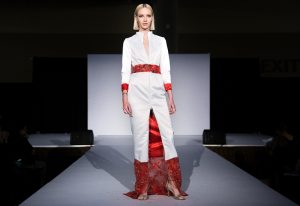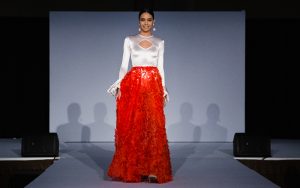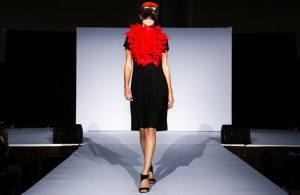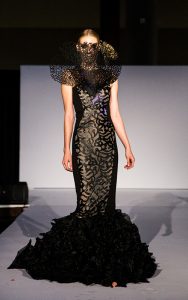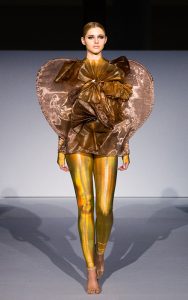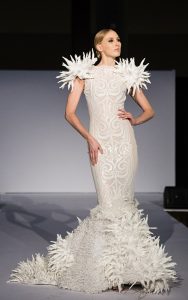By MELINA ZUñIGA
Cronkite News
PHOENIX – A model in a pink bodysuit and a red, high-waisted couture skirt glides gracefully across the runway. But her elegant attire takes fashion beyond the traditional, featuring smart technology designed to ease a woman’s menstrual cramps.
The bodysuit, called Empowerment, is one of several cutting-edge garments made this spring by students in Arizona State University’s fashion technology class. Galina Mihaleva, who holds a doctorate in smart textiles, created the class during the 2017 fall semester. It has grown to include more than 25 students across disciplines.
Participants collaborate to create clothing inspired by scientific research, biomimicry and conceal and reveal concepts. Students get a taste of the wearable technology industry by learning about wearable computing garments, electronic textiles and smart clothes from concept development and design, to production and prototypes.
“Wearable technology is all about enabling life for the better,” Mihaleva said. “We are targeting personal issues or environmental issues and creating functional or poetic pieces that reflect or bring awareness to that.”
Dennita Sewell, a professor of practice for ASU’s fashion program, describes smart garments as “a narrow field of technology that has invaded” and now is an integral part of the fashion industry. She said it was a “perfect fit” for the class and the Materials Research Society, a member-driven organization driven to advance materials, to team up in April and host the Wearables in Smart Fabrics Fashion Show in Phoenix. The 16 student-made garments in the show used technology in a wearable context to complement the human body.
The garments included the Chrysalis Coat, which helps people with noise-sensitivity issues by playing calming sounds through threaded speakers on the hood when the wearer’s pulse reaches a certain rate. Synesthsia is a dress for people who are deaf or hearing impaired to enhance their experience at concerts by reflecting pitch frequencies with physical sensations.
Mariah Alcantar, a senior in the fashion program, created a dress to address invasion of personal space, which she said was based on biomimicry behavior used by the monarch butterfly to ward off predators.
“The sonar sensors are adjustable based on how much space each individual needs around them,” Alcantar said. “Say mine is within 3 feet of me and I don’t want you there. This garment is triggered to acknowledge the person that is within your 3-feet perimeter and it’ll move and adjust based on that.”
[blanklines number=”1″]The fashion show culminated in awards for the student designers based on functionality, aesthetic, overall design and people’s choice for originality, technical innovation, execution and usability. Taylor Tomczyk and Jacqueline Arnold’s garment, Empowerment, won the people’s choice award.
Tomczyk and Arnold, both juniors in the fashion program at ASU, wanted to design something to address cyclical menstrual discomfort. They teamed with students in the engineering program to make their vision a reality.
“We’re women, we’ve been going through this since about 15, and we wanted to create a garment that women could put on and instantly feel better,” Tomczyk said.
The result was a sheer pink bodysuit made of four-way stretch Lycra with a bright red circle skirt made of floral chiffon. An embedded heating pad that reaches 120 degrees Fahrenheit is programed to be on for 20 minutes and off for 20 minutes to help suppress cramps. The shoulders of the garment incorporate lavender aromatherapy diffusers to relax the wearer and a battery pack to help keep the bodysuit compact.
“Students are using illumination, they’re using sensors, they’re using their imagination and creativity with the technology,” Sewell said. “Some of the students are working on garments, many of them to help people, to help things that are a part of the human condition or our society.”
For more stories from Cronkite News, visit cronkitenews.azpbs.org.
^_=
